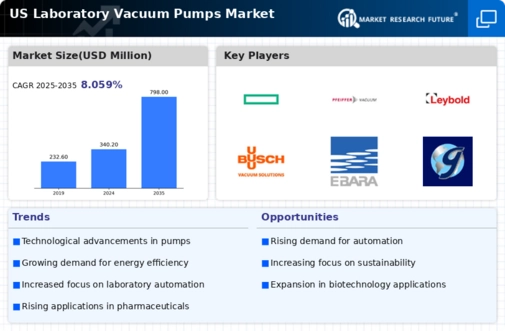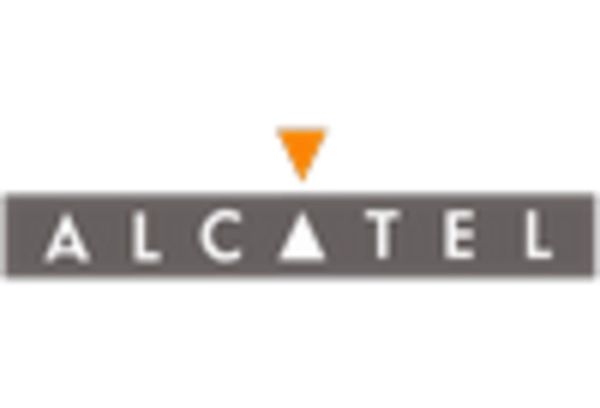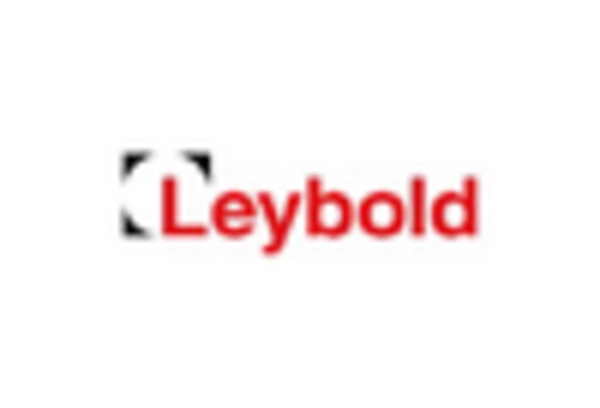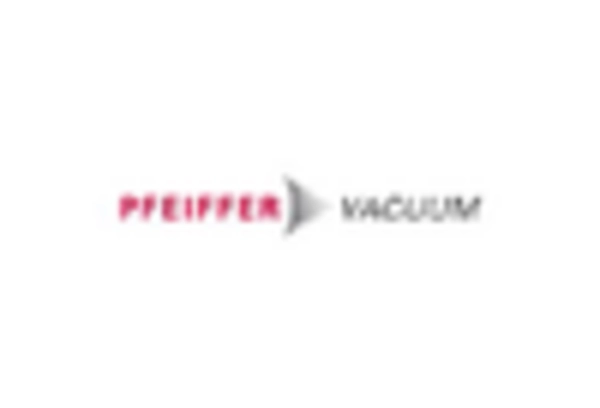Emergence of Advanced Materials
The laboratory vacuum-pumps market is experiencing a transformation due to the emergence of advanced materials that require specialized vacuum systems for processing. Industries such as nanotechnology and materials science are increasingly utilizing laboratory vacuum-pumps to create and manipulate materials at the molecular level. This trend is expected to drive the market as researchers seek precise vacuum conditions to achieve desired material properties. The laboratory vacuum-pumps market is projected to grow by approximately 4.8% annually as these advanced applications gain traction. The ability to control environmental conditions during material synthesis and characterization is crucial, thereby enhancing the demand for sophisticated vacuum solutions. As research in advanced materials continues to evolve, the laboratory vacuum-pumps market is likely to adapt and expand to meet these new challenges.
Growth in Pharmaceutical Manufacturing
The laboratory vacuum-pumps market is poised for growth due to the expansion of pharmaceutical manufacturing in the United States. As the pharmaceutical industry continues to innovate and develop new drugs, the need for efficient vacuum systems becomes increasingly critical. In 2025, the pharmaceutical sector is expected to contribute significantly to the laboratory vacuum-pumps market, with projections indicating a market value of over $600 million. This growth is driven by the necessity for vacuum systems in processes such as freeze-drying, solvent removal, and filtration. The laboratory vacuum-pumps market benefits from the rising demand for high-quality pharmaceuticals, as manufacturers seek to optimize their production processes. Consequently, advancements in vacuum technology that enhance efficiency and reduce operational costs are likely to gain traction within this sector.
Rising Demand in Research Laboratories
The laboratory vacuum-pumps market experiences a notable surge in demand driven by the increasing number of research laboratories across the United States. As scientific research expands, particularly in fields such as pharmaceuticals and biotechnology, the need for efficient vacuum systems becomes paramount. In 2025, the market is projected to reach approximately $1.5 billion, reflecting a compound annual growth rate (CAGR) of around 5.2% from previous years. This growth is largely attributed to the necessity for precise control in experimental conditions, which laboratory vacuum-pumps provide. Furthermore, the trend towards more complex experiments necessitates advanced vacuum solutions, thereby propelling the laboratory vacuum-pumps market forward. The integration of these systems into various laboratory processes enhances productivity and accuracy, making them indispensable in modern research environments.
Increased Focus on Laboratory Efficiency
The laboratory vacuum-pumps market is significantly impacted by the growing emphasis on laboratory efficiency and productivity. Laboratories are increasingly seeking ways to optimize their workflows, reduce downtime, and enhance overall performance. This trend is reflected in the rising adoption of advanced vacuum systems that offer improved reliability and faster processing times. In 2025, the market is anticipated to witness a growth rate of around 5.5%, driven by the need for efficient laboratory operations. The integration of automation and smart technologies into vacuum systems further supports this trend, allowing for real-time monitoring and control. As laboratories strive to maximize their output while minimizing costs, the laboratory vacuum-pumps market is likely to benefit from innovations that enhance operational efficiency.
Regulatory Compliance and Quality Standards
The laboratory vacuum-pumps market is significantly influenced by stringent regulatory compliance and quality standards imposed by various governing bodies in the United States. Laboratories are required to adhere to specific guidelines to ensure safety and reliability in their operations. This has led to an increased investment in high-quality vacuum systems that meet these standards. For instance, compliance with ISO and ASTM standards necessitates the use of advanced vacuum technology, which in turn drives the demand for laboratory vacuum-pumps. As laboratories strive to maintain accreditation and meet regulatory requirements, the laboratory vacuum-pumps market is likely to see sustained growth. The emphasis on quality assurance and control in laboratory settings further underscores the importance of reliable vacuum systems, thereby enhancing their market presence.

















Leave a Comment